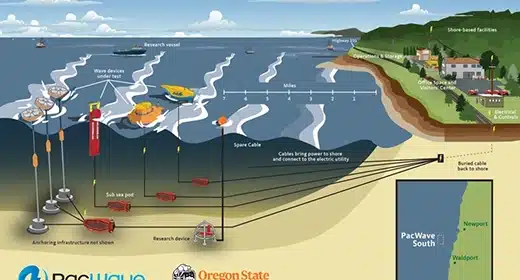by John Fialka: A facility off the coast of Oregon is being constructed to test devices to harness wave power that resemble everything from buoys to carpets.
CLIMATEWIRE | Construction crews working a few miles offshore from the port of Newport, Ore., are building the final portions of a sprawling $80 million test facility designed to develop a new form of clean energy: machines that can convert the power of ocean wave movements into electricity.
They are finishing the conduits for undersea cables designed to feed power from a variety of offshore devices to the Western power grid.
The facility, called PacWave South, is the latest part of a multinational effort to fill a gap that experts predict will grow as more nations shift to solar and wind energy and as traditional power plants that rely on coal or natural gas eventually shut down to reduce carbon emissions.
Burke Hales, PacWave’s chief scientist, said the constant motion of the ocean could provide energy at times of waning wind and solar power. Unlike solar energy, “wave power does not set,” Hales said in an interview, referring to sunsets.
The machines that his facility is being designed to test is called “wave energy conversion devices.” One of the biggest questions surrounding them is whether they can withstand the damaging corrosion of salt water and the constant pounding of ocean waves to help meet future clean energy standards.
There’s more familiarity with the issue in Europe, where nations have been supporting a similar facility — the European Marine Energy Centre — that has been operating since 2003. Tests are critical because the first machines that can extract energy from wave movements are at the stage that large wind-powered turbines were when they first emerged in the 1980s.
“The devices are very different. Some look like snakes, some are flat, some are buoys that pop up and down. There could be a carpet-like structure that harnesses electricity by changing its shape in response to the motion of the waves. It’s the Wild West out there,” explained Levi Kilcher, an engineer at the Water Power Technologies Office of the Department of Energy, which helps fund PacWave.
Hales, an expert on climate change and oceans, estimates that developing the power of wave energy could provide 10 to 15 percent to the nation’s electricity, once the technology is perfected.
PacWave is owned by Oregon State University and works in partnership with DOE. It’s intended to be an updated version of the European testing center, according to Hales, who expects tests to begin sending wave-powered electricity to the power grid by 2025.
The testing facility, which is being built in the ocean about 7 miles from the Oregon shore, consists of four bays formed by anchored, floating buoys that are connected by cables. As many as 20 devices can be tested at once.
The most productive areas for ocean-powered electricity in the world so far have been large inlets near shore where regular tide movement can be captured by spinning relatively simple underwater turbines. Alaska’s Cook Inlet, according to some estimates, could supply all the state’s power.Sign Up
“The problem is that they are highly localized,” Hales said, because such tidal areas are relatively rare and are usually far away from power grids. PacWave will have a direct grid connection and if future tests show that some of the wave conversion devices are reliable, large segments of the U.S. coastal population could benefit from their clean energy, according to one DOE study.
But as another study put it: “Oceans heave up and down, surge back and forth and even swirl in circles. These chaotic movements can be challenging to harness, and there are hundreds of technological designs vying for commercial success in the marine energy industry.”
PacWave’s job is to pick the winners.
Hales has gotten advice from the European center and some from the U.S. Navy, which has been operating a smaller testing facility in Hawaii that is focused on what it calls autonomous underwater vehicles, or AUVs.
These underwater drones are built to detect enemy submarines and mines. Their range could be vastly extended by wave-powered underwater electric recharging stations, an area the Navy and some companies are interested in developing.
PacWave’s planned tests will involve over 30 companies ranging from GE Research to a variety of startups and a few universities. Hales said he expects that the private market will take over the funding of wave-derived energy by 2030.
The devices that could emerge by then to tap the power of waves is unpredictable, he said, pointing to several memorable devices. One of his favorites is called the “Pelamis Snake,” a long, tubular device that had several joints. The segments flexed in different directions when the snake was hit by the curvature of waves. A Scottish company, Pelamis Wave Power, found a way to capture the energy by using hydraulic motors and electric generators.
Several companies failed to develop similar designs, Hales said, but in 2015, China began testing its own version called Dragon 1.
Reprinted from E&E News with permission from POLITICO, LLC. Copyright 2023. E&E News provides essential news for energy and environment professionals.





















































